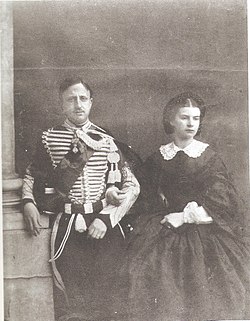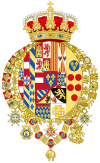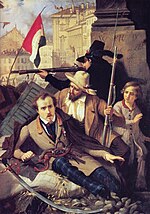| Francis II | |||||
|---|---|---|---|---|---|
 King Francis II, c. 1865 King Francis II, c. 1865 | |||||
| King of the Two Sicilies | |||||
| Reign | 22 May 1859 – 20 March 1861 | ||||
| Predecessor | Ferdinand II | ||||
| Successor | Position abolished Land seized by Kingdom of Italy under Victor Emmanuel II | ||||
| Head of the House of Bourbon-Two Sicilies | |||||
| Tenure | 20 March 1861 – 27 December 1894 | ||||
| Successor | Prince Alfonso | ||||
| Born | (1836-01-16)16 January 1836 Royal Palace of Naples, Naples, Kingdom of the Two Sicilies (now Naples, Italy) | ||||
| Died | 27 December 1894(1894-12-27) (aged 58) Arco, Austria-Hungary (now Arco, Italy) | ||||
| Burial | Basilica of Santa Chiara, Naples | ||||
| Spouse |
Maria Sophie of Bavaria
(m. 1859) | ||||
| Issue | Princess Maria Cristina Pia | ||||
| |||||
| House | House of Bourbon-Two Sicilies | ||||
| Father | Ferdinand II | ||||
| Mother | Maria Christina of Savoy | ||||
| Religion | Catholicism | ||||
| Signature | |||||
Francis II (Neapolitan and Italian: Francesco II, Sicilian: Francischieddu; christened Francesco d'Assisi Maria Leopoldo; 16 January 1836 – 27 December 1894) was King of the Two Sicilies. He was the last King of the Two Sicilies as successive invasions by Giuseppe Garibaldi and Victor Emmanuel II of Sardinia ultimately brought an end to his rule, as part of Italian unification. After he was deposed, the Kingdom of the Two Sicilies and the Kingdom of Sardinia were merged into the newly formed Kingdom of Italy.
Early life
The only son and heir of King Ferdinand II of the Two Sicilies by his first wife, Maria Christina of Savoy, Francis II was the last of the Bourbon kings of Naples, where he was born in 1836. His education had been much neglected and he proved a man of weak character, greatly influenced by his stepmother, Archduchess Maria Theresa of Austria, whom he feared, and also by the priests and the camarilla, the reactionary court set.
On 3 February 1859 in Bari, Francis married Duchess Maria Sophie of Bavaria, of the royal Bavarian house of Wittelsbach (a younger sister of Empress Elisabeth "Sissi" of Austria). However, their marriage was unhappy. Their only daughter, Maria Cristina Pia, was born ten years after her parents married and lived only three months (24 December 1869 – 28 March 1870).
Reign
Francis II took the throne on 22 May 1859, after the death of his father. For the post of prime minister, he at once appointed Carlo Filangieri, who realised the importance of the Franco-Piedmontese victories in Lombardy and advised Francis II to accept the alliance with the Kingdom of Sardinia proposed by Cavour. On 7 June, a part of the Swiss Guard mutinied, and while the king mollified them by promising to redress their grievances, General Alessandro Nunziante gathered his troops, who surrounded the mutineers and shot them down. The incident resulted in the disbanding of the whole Swiss Guard, which was the strongest bulwark of the Bourbon dynasty.

Cavour again proposed an alliance to divide the Papal States between Piedmont and Naples (the province of Rome excepted), but Francis rejected the idea, which to him seemed like heresy. Filangieri strongly advocated a constitution as the only measure which might save the dynasty, but on the king's refusal, he resigned.
Garibaldi's invasion

Meanwhile, the revolutionary parties were conspiring for the overthrow of the Bourbons in Calabria and Sicily, and Giuseppe Garibaldi was preparing for a raid in the south of Italy. A conspiracy in Sicily was discovered and the plotters punished with brutal severity, but Rosalino Pilo and Francesco Crispi, who had organised the movement, escaped execution. When Garibaldi landed at Marsala (May 1860) with his Expedition of the Thousand, he conquered the island with astonishing ease.
Those events at last coaxed Francis II into granting a constitution, but its promulgation was followed by disorders in Naples and the resignation of several ministers; Liborio Romano became head of the government. The disintegration of the army and navy proceeded apace, and Cavour sent a Piedmontese squadron carrying troops on board to watch over these events. Garibaldi had crossed the strait of Messina and was advancing northward. After long hesitations and even an appeal to Garibaldi himself and on the advice of Romano, Francis II left Naples on 6 September with his wife, Maria Sophie; the court; and the diplomatic corps (except the French and British ministers) and went by sea to Gaeta, where a large part of the army was concentrated.
The next day, Garibaldi entered Naples, was enthusiastically welcomed, and formed a provisional government.
Piedmontese invasion
King Victor Emmanuel II had decided on the invasion of the Papal States and after occupying Umbria and the Marche, he entered the Neapolitan kingdom. Garibaldi's troops defeated the Neapolitan royalists at the Battle of Volturno, which took place on 1 October 1860, and the Piedmontese captured Capua.
By late 1860, only Gaeta, Messina and Civitella del Tronto still held out. The Siege of Gaeta by the Piedmontese began on 6 November 1860. Both Francis II and his wife behaved with great coolness and courage. Even after the French fleet, whose presence had prevented an attack by sea, was withdrawn, they still resisted. It was not until 13 February 1861 that the fortress capitulated.
Overthrow
Thus, the Kingdom of the Two Sicilies ceased to exist, and its territory was incorporated into that of the Kingdom of Sardinia (soon renamed the Kingdom of Italy), and Francis II was deposed. Francis and Maria Sophie first lived in Rome as guests of the Pope, where they maintained a government in exile that was recognised by some Catholic powers, including France, Spain, Austria-Hungary and Bavaria. After the Prussian victory against Austria in 1866 and the subsequent expansion of Italian territory, they disbanded this government and left Rome before it was occupied by the Italians in 1870. They led a wandering life from then on by living in Austria, France and Bavaria. In 1894, Francis died at Arco in Trentino (now north-eastern Italy, but at the time in Austria-Hungary). His widow survived him by 31 years and died in Munich.
Upon the death of Francis II, his half-brother, Prince Alfonso, became the pretender to the throne of the Kingdom of the Two Sicilies.
Cause of beatification and canonization
On 11 December 2020, the cause of the beatification of King Francis II of the Two Sicilies was introduced by Crescenzio Cardinal Sepe, the Archbishop of Naples. Pope Francis declared the king a Servant of God.
Honours
| Styles of Francis II of the Two Sicilies | |
|---|---|
 | |
| Reference style | His Majesty |
| Spoken style | Your Majesty |
 Belgium: Grand Cordon of the Order of Leopold, 9 June 1855
Belgium: Grand Cordon of the Order of Leopold, 9 June 1855 Spain: Knight of the Order of the Golden Fleece, 15 June 1844
Spain: Knight of the Order of the Golden Fleece, 15 June 1844 Empire of Brazil: Grand Cross of the Order of Pedro I
Empire of Brazil: Grand Cross of the Order of Pedro I Austrian Empire:
Austrian Empire:
- Grand Cross of the Order of St. Stephen, 1849
- Knight of the Military Order of Maria Theresa, 1861
 Kingdom of France: Knight Grand Cross of the Royal and Military Order of Saint Louis
Kingdom of France: Knight Grand Cross of the Royal and Military Order of Saint Louis Kingdom of Prussia:
Kingdom of Prussia:
- Knight of the Order of the Black Eagle, 4 June 1853
- Pour le Mérite (military), 20 February 1861
 Kingdom of Bavaria: Knight of the Order of Saint Hubert, 1857
Kingdom of Bavaria: Knight of the Order of Saint Hubert, 1857 Kingdom of Saxony: Knight of the Order of the Rue Crown, 1860
Kingdom of Saxony: Knight of the Order of the Rue Crown, 1860 Grand Duchy of Tuscany: Grand Cross of the Order of St. Joseph
Grand Duchy of Tuscany: Grand Cross of the Order of St. Joseph Württemberg: Grand Cross of the Order of the Württemberg Crown, 1864
Württemberg: Grand Cross of the Order of the Württemberg Crown, 1864
Ancestors
| Ancestors of Francis II of the Two Sicilies |
|---|
See also
References
 This article incorporates text from a publication now in the public domain: Villari, Luigi (1911). "Francis II. of the Two Sicilies". In Chisholm, Hugh (ed.). Encyclopædia Britannica. Vol. 10 (11th ed.). Cambridge University Press. p. 936.
This article incorporates text from a publication now in the public domain: Villari, Luigi (1911). "Francis II. of the Two Sicilies". In Chisholm, Hugh (ed.). Encyclopædia Britannica. Vol. 10 (11th ed.). Cambridge University Press. p. 936.
- ^ Villari 1911.
- "The Bourbons in Exile". Archived from the original on 2012-09-15. Retrieved 2013-04-20.
- "On the Opening of the Beatification Process of Francis II of Bourbon-Two Sicilies". Sito Ufficiale del Sacro Militare Ordine Costantiniano di San Giorgio - Official Site of the Sacred Military Constantinian Order of St George | Site Officiel de l’Ordre Sacré et Militaire Constantinien de Saint-Georges | Sitio official de la Sagrada Orden Militar Constantiniana de San Jorge | Die offizielle Webseite des heiligen konstantinischen Ritterordens vom Heiligen Georg. 2020-12-16. Retrieved 2022-01-24.
- Ferdinand Veldekens (1858). Le livre d'or de l'ordre de Léopold et de la croix de fer. lelong. p. 184.
- "Caballeros de la insigne orden del toisón de oro". Guía Oficial de España (in Spanish). 1893. p. 137. Retrieved 13 August 2020.
- "Ritter-Orden", Hof- und Staatshandbuch der Österreichisch-Ungarischen Monarchie, 1894, pp. 62, 64, retrieved 13 August 2020
- "Königlich Preussische Ordensliste", Preussische Ordens-Liste (in German), 1, Berlin: 5, 11, 1886 – via hathitrust.org
- Hof- und Staats-Handbuch des Königreichs Bayern (in German). Königl. Oberpostamt. 1867. p. 8. Retrieved 2019-07-15.
- Staatshandbuch für den Freistaat Sachsen: 1865/66. Heinrich. 1866. p. 4.
- Almanacco Toscano per l'anno 1855. Stamperia Granducale. 1840. p. 275.
- Hof- und Staats-Handbuch des Königreich Württemberg (1886/7), "Königliche Orden" p. 22
External links
 Media related to Francis II of the Two Sicilies at Wikimedia Commons
Media related to Francis II of the Two Sicilies at Wikimedia Commons
| Francis II of the Two Sicilies House of Bourbon-Two SiciliesCadet branch of the House of BourbonBorn: 16 January 1836 Died: 27 December 1894 | ||
| Regnal titles | ||
|---|---|---|
| Preceded byFerdinand II | King of the Two Sicilies 22 May 1859 – 20 March 1861 |
Kingdom Abolished Italian Unification under the House of Savoy |
| Titles in pretence | ||
| Preceded byHimself | — TITULAR — King of the Two Sicilies 20 March 1861 – 27 December 1894 |
Succeeded byPrince Alfonso, Count of Caserta |
| Kings and Princes of the Two Sicilies | |
|---|---|
| Generations, in accordance with agnatic succession, are numbered by descent from Ferdinand I | |
| 1st generation | |
| 2nd generation | |
| 3rd generation | |
| 4th generation | |
| 5th generation | |
| 6th generation | |
| 7th generation | |
| 8th generation | |
| Kings are in italics | |
- 1836 births
- 1894 deaths
- Princes of Bourbon-Two Sicilies
- Monarchs of the Kingdom of the Two Sicilies
- Diabetes-related deaths
- Burials at the Basilica of Santa Chiara
- Grand Crosses of the Order of Saint Stephen of Hungary
- Knights Cross of the Military Order of Maria Theresa
- Knights of the Golden Fleece of Spain
- Recipients of the Pour le Mérite (military class)
- 19th-century Roman Catholics
- Italian Roman Catholics
- Italian Servants of God
- Roman Catholic royal saints
- Royal reburials
- Dethroned monarchs
